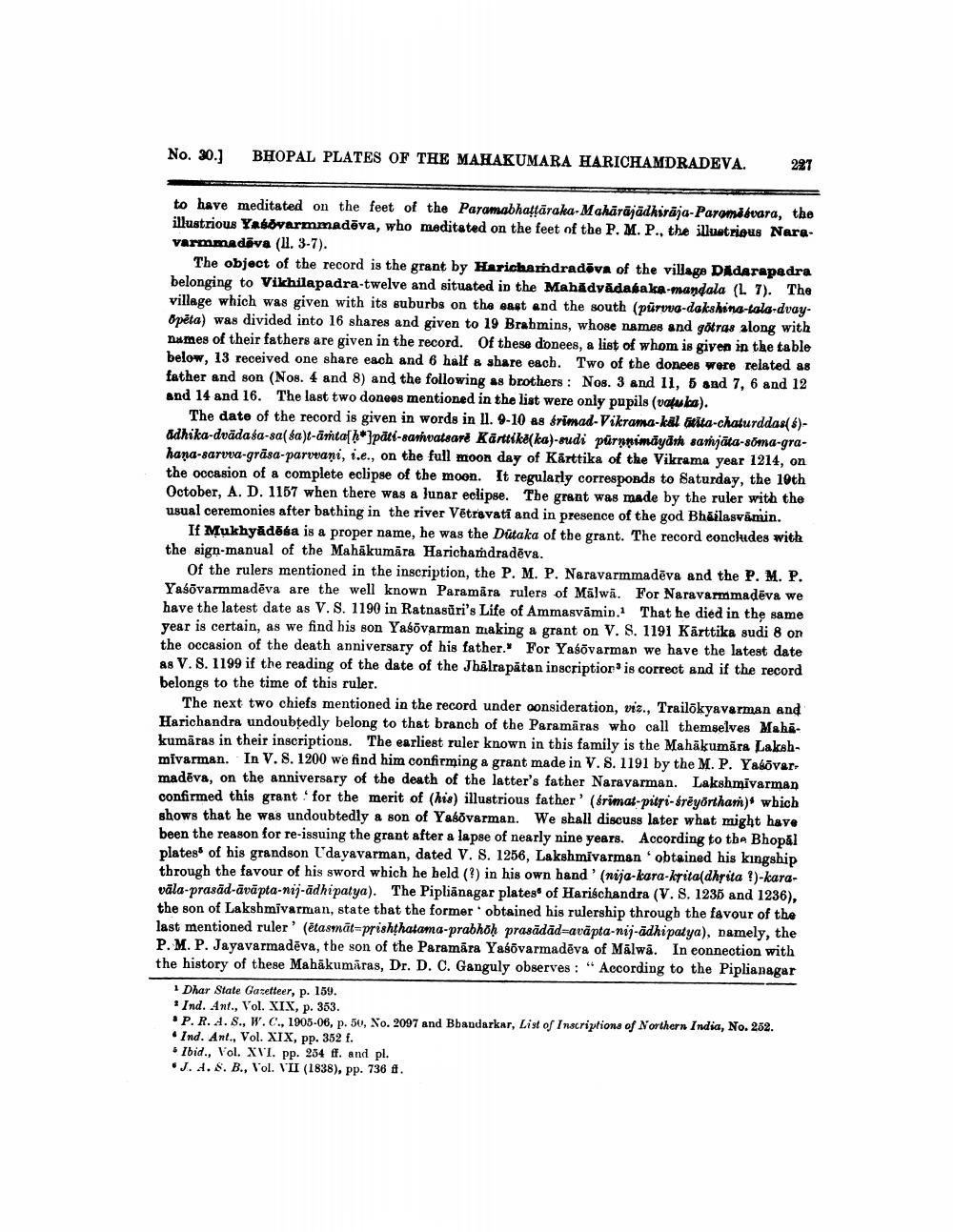________________
No. 30.)
BHOPAL PLATES OF THE MAHAKUMARA HARICHAMDRADEVA.
227
to have meditated on the feet of the Paramabhattāraka-Mahārājādhirāja-Paromi buara, the illustrious Yasovarmmadova, who meditated on the feet of the P. M. P., the illustrious Naravarmmadava (11.3-7).
The object of the record is the grant by Harichardradova of the village Didarapedra belonging to Vikhilapadra-twelve and situated in the Mahädyādasaka mandala (L. 7). The village which was given with its suburbs on the east and the south (pürvua-dakshina-lala-dvayOpēta) was divided into 16 shares and given to 19 Brahmins, whose names and götras along with names of their fathers are given in the record. Of these donees, a list of whom is given in the table below, 13 received one share each and 6 half & share each. Two of the donees were related as father and son (Nos. 4 and 8) and the following as brothers : Nos. 3 and 11, 5 and 7, 6 and 12 and 14 and 16. The last two donees mentioned in the list were only pupils (vatuka).
The date of the record is given in words in 11. 9-10 as grimad-Vikrama-kül fitita-chaturddas(6)Adhika-dvādaśa-8a(ka)t-amta[h*]pāti-samvatsarė Känttiko(ka)-sudi pürnpimāyash samjāta-soma-grahana-sarvva-grāsa-parvvani, i.e., on the full moon day of Kärttika of the Vikrama year 1214, on the occasion of a complete eclipse of the moon. It regularly corresponds to Saturday, the 19th October, A. D. 1157 when there was a lunar eclipse. The grant was made by the ruler with the usual ceremonies after bathing in the river Vētrevati and in presence of the god Bhāilasvamin.
If Mukhyādēsa is a proper name, he was the Dütaka of the grant. The record concludes with the sign-manual of the Mahākumāra Harichandradeva.
Of the rulers mentioned in the inscription, the P. M. P. Naravarmmadēva and the P. M. P. Yaśövarmmadēva are the well known Paramāra rulers of Mālwā. For Naravarmmadēva we have the latest date as V. S. 1190 in Ratnasūri's Life of Ammasvāmin. That he died in the same year is certain, as we find his son Yaśõvarman making a grant on V. S. 1191 Kārttika sudi 8 on the occasion of the death anniversary of his father." For Yaśõvarman we have the latest date A: V. S. 1199 if the reading of the date of the Jhālrapätan inscription is correct and if the record belongs to the time of this ruler.
The next two chiefs mentioned in the record under consideration, viz., Trailokyavarman and Harichandra undoubtedly belong to that branch of the Paramaras who call themselves Mahakumāras in their inscriptions. The earliest ruler known in this family is the Mahākumāra Lakshmivarman. In V.S. 1200 we find him confirming a grant made in V. S. 1191 by the M.P. Yaśõver. madēva, on the anniversary of the death of the latter's father Naravarman. Lakshmivarman confirmed this grant for the merit of (his) illustrious father' (srimat-pitsi-frēyörthan)* which shows that he was undoubtedly a son of Yasovarman. We shall discuss later what might have been the reason for re-issuing the grant after a lapse of nearly nine years. According to the Bhopal plates of his grandson t'dayavarman, dated V. S. 1256, Lakshmivarman obtained his kingship through the favour of his sword which he held (?) in his own hand' (nija-kara-krita(dhrita ?)-karavāla-prasād-āvāpta-nij-adhipatya). The Piplianagar platego of Harischandra (V. S. 1236 and 1236), the son of Lakshmivarman, state that the former obtained his rulership through the favour of the last mentioned ruler' (ētasmāt=prishthatama-prabhoh prasādād=avāpta-nij-adhipatya), namely, the P.M.P. Jayavarmadēva, tbe son of the Paramāra Yasővarmadēva of Mälwa. In eonnection with the history of these Mahākumaras, Dr. D. C. Ganguly observes: "According to the Piplianagar
1 Dhar State Gazetteer, p. 159.
Ind. Ant., Vol. XIX, p. 353. .P.R..S., W.C., 1905-06, p. 50, No. 2097 and Bbandarkar, List of Inscriptions of Northern India, No. 252. • Ind. Ant., Vol. XIX, pp. 352 f. • Ibid., Vol. XVI. pp. 254 ff. and pl. • J. d. 8. B., Vol. VII (1838), pp. 736 ft.




